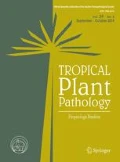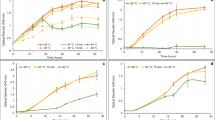Abstract
Phytophthora blight is the most devastating disease for pepper (Capsicum annuum L.) production and is caused by Phytophthora capsici. Current management strategies are not effective. Our study assessed the multi-trait effects of Paenibacillus polymyxa, which suppresses Phytophthora blight and promotes plant growth in pepper plants. A total of 82 bacterial strains isolated from rhizosphere soil of pepper plants were screened for in vitro inhibition of P. capsici growth. The results revealed that only six strains showed strong antagonistic activity against P. capsici. These six strains were used for controlling Phytophthora blight in pepper by seedling assays under greenhouse conditions. Three strains showed a lower incidence of Phytophthora blight and were used in further growth-promoting and biocontrol studies under greenhouse conditions. Strain YCP16-23 showed >60.0% suppression of P. capsici and significantly promoted growth of pepper plants compared to the untreated control. Based on cultural and morphological characterization and 16S rRNA gene sequencing, strain YCP16-23 was identified as Paenibacillus polymyxa. Strain YCP16-23 demonstrated many characteristics that are beneficial for plants, such as production of α-amylase, ammonia, cellulase, indole-3-acetic acid, pectinase, siderophores, and protease, as well as solubilization of phosphate. In a two-year field trial, strain YCP16-23 exhibited remarkable disease suppressing effect by controlling Phytophthora blight (76.24% and 38.09% in years 2017 and 2018, respectively) compared with the untreated control. Strain YCP16-23 caused disease suppression comparable to the microbial fungicides ‘Cike’ (72.04% and 15.41%) and Fluazinam (80.47% and 5.24%). Overall, the results suggest that strain YCP16-23 could provide protection against Phytophthora blight via direct and indirect modes of action and can be used as a biocontrol agent.





Similar content being viewed by others
References
Adesemoye AO, Kloepper JW (2009) Plant-microbes interactions in enhanced fertilizer use efficiency. Applied Microbiology and Biotechnology 85:1–12
Adesemoye AO, Torbert HA, Kloepper JW (2009) Plant growth-promoting rhizobacteria allow reduced application rates of chemical fertilizers. Microbial Ecology 58:921–929
Batista BD, Lacava PT, Ferrari A, Teixeira-Silva NS, Bonatelli ML, Tsui S, Mondin M, Kitajima EW, Pereira JO, Azevedo JL, Quecine MC (2018) Screening of tropically derived, multi-trait plant growth-promoting rhizobacteria and evaluation of corn and soybean colonization ability. Microbiological Research 206:33–42
Bhattacharyya PN, Jha DK (2012) Plant growth-promoting Rhizobacteria (PGPR): emergence in agriculture. World Journal of Microbiology and Biotechnology 28:1327–1350
Bhattacharyya D, Garladinne M, Lee YH (2015) Volatile indole produced by rhizobacterium Proteus vulgaris JBLS202 stimulates growth of Arabidopsis thaliana through auxin, cytokinin, and brassinosteroid pathways. Journal of Plant Growth Regulation 34:158–168
Bric JM, Bostock RM, Silverstone SE (1991) Rapid in situ assay for indoleacetic acid production by bacteria immobilized on a nitrocellulose membrane. Applied and Environmental Microbiology 57:535–538
Calvo P, Watts DB, Kloepper JW, Torbert HA (2017) Effect of microbial-based inoculants on nutrient concentrations and early root morphology of corn (Zea mays). Journal of Plant Nutrition and Soil Science 180:56–70
Dey R, Pal KK, Bhatt DM, Chauhan SM (2004) Growth promotion and yield enhancement of peanut (Arachis hypogaea L.) by application of plant growth-promoting rhizobacteria. Microbiological Research 159:371–394
Dinesh R, Anandaraj M, Kumar A, Srinivasan V, Bini YK, Subila KP, Aravind R, Hamza S (2013) Effects of plant growth promoting rhizobacteria and NPK fertilizers on biochemical and microbial properties of soils under ginger (Zingiber officinale Rosc.) cultivation. Agricultural Research 2:346–353
Dinesh R, Anandaraj M, Kumar A, Srinivasan V, Bini YK, Subila KP, Aravind R (2015) Isolation, characterization, and evaluation of multi-trait plant growth promoting rhizobacteria for their growth promoting and disease suppressing effects on ginger. Microbiological Research 173:34–43
Garcia FP, Menendez E, Rivas R (2015) Role of bacterial bio fertilizers in agriculture and forestry. AIMS Bioengineering 2:183–205
Gómes-Sagasti MT, Marino D (2015) PGPRs and nitrogen-fixing legumes: a perfect team for efficient Cd phytoremediation? Frontiers in Plant Science 6:81
Gouda S, Kerry RG, Das G, Paramithiotis S, Shin HS, Patra JK (2018) Revitalization of plant growth promoting rhizobacteria for sustainable development in agriculture. Microbiological Research 206:131–140
Gu Q, Yang Y, Yuan Q, Shi G, Wu L, Lou Z, Huo R, Wu H, Borriss R, Gao X (2017) Bacillomycin D produced by Bacillus amyloliquefaciens is involved in the antagonistic interaction with the plant pathogenic fungus Fusarium graminearum. Applied and Environmental Microbiology 83:e01075-17
Hernández-León R, Rojas-Solís D, Contreras-Pérez M, del Carmen Orozco-Mosqueda M, Macías-Rodríguez L, Reyes-de la Cruz H, Valencia-Cantero E, Santoyo G (2015) Characterization of the antifungal and plant growth-promoting effects of diffusible and volatile organic compounds produced by Pseudomonas fluorescens strains. Biological Control 81:83–92
Jiang ZQ, Guo YH, Li SM, Qi HY, Guo JH (2006) Evaluation of biocontrol efficiency of different Bacillus preparations and field application methods against Phytophthora blight of bell pepper. Boilogical Control 36:216–223
Jiang CH, Liao MJ, Wang HK, Zheng MZ, Xu JJ, Guo JH (2018) Bacillus velezensis, a potential and efficient biocontrol agent in control of pepper gray mold caused by Botrytis cinerea. Boilogical Control 126:147–157
Kim HS, Sang MK, Jung HW, Jeun YC, Myung IS, Kim KD (2012) Identification and characterization of Chryseobacterium wanjuense strain KJ9C8 as a biocontrol agent of Phytophthora blight of pepper. Crop Protection 32:129–137
Kumar RS, Ayyadurai N, Pandiaraja P, Reddy AV, Venkateswarlu Y, Prakash O, Sakthivel N (2005) Characterization of antifungal metabolite produced by a new strain Pseudomonas aeruginosa PUPa3 that exhibits broad-spectrum antifungal activity and biofertilizing traits. Journal of Applied Microbiology 98:145–154
Lee KJ, Kamala-Kannan S, Sub HS, Seong CK, Lee GW (2008) Biological control of Phytophthora blight in red pepper (Capsicum annuum L.) using Bacillus subtilis. World Journal of Microbiology and Biotechnology 24:1139–1145
Lee SJ, Park YJ, Kim HT, Kim BS (2010) The race differentiation of Phytophthora capsici in Korea. Research in Plant Disease 16:153–157
Li ZJ, Long WP, Zheng JR, Lei JJ (2007) Isolation and identification of Phytophthora capsici in Guangdong province and measurement of their pathogenicity and physiological race differentiation. Journal of South China Agricultural University 28:50–54
Liu Y, Pan X, Li J (2015) Current agricultural practices threaten future global food production. Journal of Agricultural and Environmental Ethics 28:203–216
Long HH, Schmidt DD, Baldwin IT (2008) Native bacterial endophytes promote host growth in a species-specific manner; phytohormone manipulations do not result in common growth responses. PLoS One 3:e2702
Lugtenberg B, Kamilova F (2009) Plant-growth-promoting rhizobacteria. Annual Review of Microbiology 63:541–556
Luna-Bulbarela A, Tinoco-Valencia R, Corzo G, Kazuma K, Konno K, Galindo E, Serrno-Carreón L (2018) Effects of bacillomycin D homologues produced by Bacillus amyloliquefaciens 83 on growth and viability of Colletotrichum gloeosporioides at different physiological stages. Biological Control 127:145–154
Ma HG, He LG, Zhang HL, Li XM, Jiang JX (2013) Physiological races of Phytophthora capsici and their sensitivity to dimethomorph in Jiangxi province. Acta Phytophylacica Sinica 40:374–378
Nautiyal CS (1999) An efficient microbiological growth medium for screening phosphate solubilizing microorganisms. FEMS Microbiology Letters 170:265–270
Niu B, Vater J, Rueckert C, Blom J, Lehmann M, Ru JJ, Chen XH, Wang Q, Borriss R (2013) Polymyxin P is the active principle in suppressing phytopathogenic Erwinia spp. by the biocontrol rhizobacterium Paenibacillus polymyxa M-1. BMC Microbiology 13:137
Pérez-Flores P, Valencia-Cantero E, Altamirano-Hernández J, Pelagio-Flores R, López-Bucio J, García-Juárez P, Macías-Rodríguez L (2017) Bacillus methylotrophicus M4-96 isolated from maize (Zea mays) rhizoplane increases growth and auxin content in Arabidopsis thaliana via emission of volatiles. Protoplasma 254:2201–2213
Rybakova D, Cernava T, Köberl M, Liebminger S, Etemadi M, Berg G (2016) Endophytes-assisted biocontrol: novel insights in ecology and the mode of action of Paenibacillus. Plant and Soil 405:125–140
Sang MK, Kim KD (2012) Plant growth-promoting rhizobacteria suppressive to Phytophthora blight affect microbial activities and communities in the rhizosphere of pepper (Capsicum annuum L.) in the field. Applied Soil Ecology 62:88–97
Schwyn B, Neilands JB (1987) Universal chemical assay for the detection and determination of siderophores. Analytical Biochemistry 160:47–56
Shahbaz M, Ashraf M (2013) Improving salinity tolerance in cereals. Critical Reviews in Plant Sciences 32:237–249
Tabassum B, Khan A, Tariq M, Ramzan M, Khan MSI, Shahid N (2017) Bottlenecks in commercialisation and future prospects of PGPR. Applied Soil Ecology 121:102–117
Tamura K, Stecher G, Peterson D, Filipski A, Kumar S (2013) MEGA6: molecular evolutionary genetics analysis version 6.0. Molecular Biology and Evolution 30:2725–2729
Tilman D, Balzer C, Hill J, Befort BL (2011) Global food demand and the sustainable intensification of agriculture. Proceedings of the National Academy of Sciences, USA 108:20260–20264
Vacheron J, Desbrosses G, Bouffaud ML, Touraine B, Moënne-Loccoz Y, Muller D, Legendre L, Wisniewski-Dyé F, Combaret CP (2013) Plant growth promoting rhizobacteria and root system functioning. Frontiers in Plant Science 4:356
Weselowski B, Nathoo N, Eastman AW, Macdonald J, Yuan ZC (2016) Isolation, identification and characterization of Paenibacillus polymyxa CR1 with potentials for biopesticide, biofertilization, biomass degradation and biofuel production. BMC Microbiology 16:244
Xu SJ, Kim BS (2014) Biocontrol of Fusarium crown and root rot and promotion of growth of tomato by Paenibacillus strains isolated from soil. Mycobiology 42:158–166
Xu S, Kim BS (2016) Evaluation of Paenibacillus polymyxa strain SC09-21 for biocontrol of Phytophthora blight and growth stimulation in pepper plants. Tropical Plant Pathology 41:162–168
Xu SJ, Hong SJ, Choi W, Kim BS (2014) Antifungal activity of Paenibacillus kribbensis strain T-9 isolated from soils against several plant pathogenic fungi. Plant Pathology Journal 30:102–108
Yang MY, Cao JF, Li XD, Sun DW, Wang YC, Zhao ZJ (2009) Molecular diagnosis and characterization of blight disease pathogen on pepper in Yunnan. Acta Phytopathologica Sinica 39:297–303
Yaoyao E, Yuan J, Yang F, Wang L, Ma J, Li J, Pu X, Raza W, Huang Q, Shen Q (2017) PGPR strain Paenibacillus polymyxa SQR-21 potentially benefits watermelon growth by re-shaping root protein expression. AMB Express 7:104
Zhang F, Li XL, Zhu SJ, Ojaghian MR, Zhang JZ (2018) Biocontrol potential of Paenibacillus polymyxa against Verticillium dahlia infecting cotton plants. Biological Control 127:70–77
Acknowledgments
This work was supported by National Key Research and Development Program of China (2017YFD0201100, 2017YFD0200600), Agricultural Science and Technology Innovation Special Project of Gansu Academy of Agricultural Sciences (2016GAAS26, 2017GAAS23, 2019GAAS02), Agricultural Biotechnology Research and Application Development Project in Gansu Province (GNSW-2016-18).
Author information
Authors and Affiliations
Corresponding author
Additional information
Publisher’s note
Springer Nature remains neutral with regard to jurisdictional claims in published maps and institutional affiliations.
Rights and permissions
About this article
Cite this article
Xu, SJ., Jing, ZQ., Guo, ZJ. et al. Growth-promoting and disease-suppressing effects of Paenibacillus polymyxa strain YCP16-23 on pepper (Capsicum annuum) plants. Trop. plant pathol. 45, 415–424 (2020). https://doi.org/10.1007/s40858-020-00360-x
Received:
Accepted:
Published:
Issue Date:
DOI: https://doi.org/10.1007/s40858-020-00360-x




